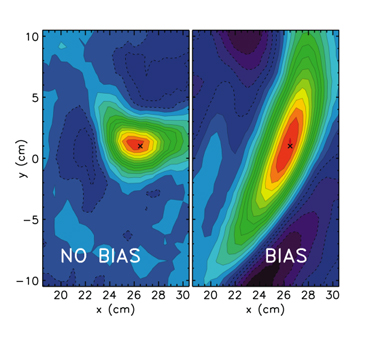
The high-confinement mode or H-mode is an important regime in tokamaks where turbulent transport is suppressed in a region where strong shear flows exist (the transport barrier). An often used qualitative explanation of turbulence suppression is that the sheared flow "rips apart" turbulent eddies, creating smaller eddies which are less efficient at transport.
Theoretically, shear flow is predicted to cause radial decorrelation (rip apart eddies), reduce turbulent amplitude, and modify the cross-phase between fluctuating density and electric field. We have driven sheared flow in the edge of LAPD through biasing (in collaboration with Dr. James Maggs, David Pace, and Dr. Robert Taylor). If the applied bias exceeds a threshold, dramatic steepening of the edge density profile is observed indicating suppression of turbulent transport.
Detailed measurements of the turbulence in the edge show that while the amplitude is reduced, the primary cause of the transport suppression is modification of the cross-phase. Two-dimensional cross-correlation measurements show that while the correlation function is stretched azimuthally in the presence of the shear flow, the radial correlation length is not significantly altered (see figure on left) (T.A Carter, J.E. Maggs, and D.C. Pace, Euro. Conf. Abs., 29C, O-4.017 (2005)).
Click here for a movie of the 2D cross-correlation (still frame above). Time in the movie is correlation delay.
For information on other plasma physics research activities at UCLA, visit the Plasma Science and Technology Institute website.